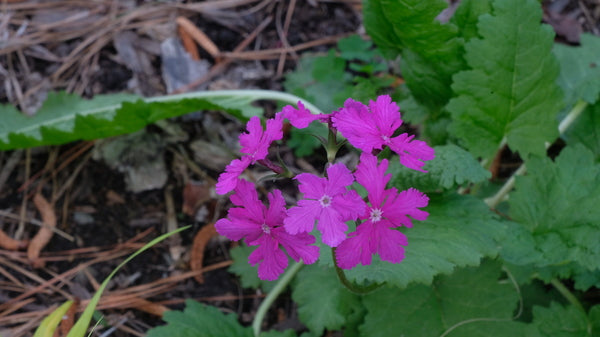Primula sieboldii 'Oasahi'
Oasahi Siebold's Primrose
This plant is not currently for sale. This is an archive page preserved for informational use.
Shop Available PrimulaItem #: 9767
Zones: 5a to 7b
Dormancy: Winter, Summer, Fall
Height: 8" tall
Culture: Part Sun to Light Shade
Origin: Japan, Korea, Siberia Russia
Pot Size: 3.5" pot (24 fl. oz/0.7 L)
Primula sieboldii 'Oasahi' is a lovely cultivar of Siebold's primrose, giving rise in early spring to 8" spikes, topped with a carousel of pink-lavender flowers. Primula sieboldii 'Oasahi' is an easy-to-grow groundcover, forming a slow spreading, summer-deciduous patch to 18" wide in five years.
Maintenance:
The only maintenance which might be necessary when growing Primula sieboldii might be to remove the old foliage and flower stalks as it goes dormant come hot weather. But memory suggests that it might quietly disappear on its own. It might be beneficial to mark its location so one does not dig it up while it is dormant.
Growing Conditions:
'Oasahi' is a woodland plant which returns from dormancy in late winter and flowers in spring. While in growth it makes use of the sunlight available while the tree canopy is leafless and the greater moisture available at that time of the year. Like many a native spring ephemeral it goes dormant by early summer as growing conditions become less hospitable. This is a species that thrives in the growing conditions of the southeast US. Moist well drained soils suit it best; avoid soggy sites.
Garden Value:
A charming addition to the spring bloom display in a shade garden. The flowers vary from white to pale pink through rich dark purple. Flowers are often bi-colored and quite beautifully snowflake shaped. The foliage is also an asset, being a lively spring green and roughly arrow shaped, with a scalloped edge and deeply impressed veins. Primula sieboldii spreads at a modest rate and could be used as a small scale ground cover though it only covers the ground for about one third of the year. Its early rising habit makes it a good companion for plants that are late to come into new growth in the spring such as some Hosta and some Arisaema (Jack-in-the-Pulpits); thereby two plants occupying the same site but at opposite seasons.


-
Related Articles
-
Other Attributes
Genus: Primula
Flower Color: Purple/Lavender
Leaf Color: Green
Bloom Time: Spring
Garden Themes: Cottage Garden Plants , Rock Garden Plants
Other: Drought Tolerant Plants , Dry Shade Plants , Dwarf Plants , Pollinator Plants , Plants from Japan , Plants that Attract Birds


